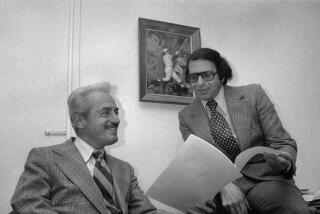THE LOCKOUT: DAY 1 : THE HISTORY : Labor Strife Has Been Around Since Start of Baseball
- Share via
Labor-management disputes are old news in baseball--more than 100 years old. The National League was formed by owners in 1876 in an effort to combat the player-run National Assn., in which players were free to move from club to club. In 1890, to protest owners having set a $2,000 annual salary maximum and their use of the reserve clause and blacklisting to keep players in line, the Brotherhood of Professional Base Ball Players--an early forerunner of today’s Players Assn.--rebelled and formed a new league, the Players League. That venture lasted only one year, but labor strife has lived on.
Disagreements have become more frequent and bitter in the past 20 years as the financial stakes have grown. Here’s a look at the causes and effects:
1969: Players boycotted spring training, demanding that owners increase their contributions to the players’ pension fund and improve the health care, life insurance and pension benefits. Their three-year agreement called for owners to contribute $4.5 million annually and increase the players’ benefits. The pension eligibility requirement was lowered from five years to four years and the minimum age for drawing pension benefits from 50 to 45. Players won the right to use agents in salary negotiations with owners.
1970: Supported by the Major League Umpires Assn., umpires went on strike and refused to work the playoffs. Minor league and retired umpires worked the first two games. The subsequent agreement set a minimum salary of $11,000 and an average of $21,000.
1972: Players staged the first general strike in the game’s history. The season was delayed by 13 days and 86 games were canceled. Increasing pension benefits was again the issue. Clubs agreed to contribute an additional $490,000 to the benefit plan and to use $500,000 of the plan’s profits for additional benefits. Players won the right to go to arbitration in salary disputes.
1976: Owners locked players out of training camp for 17 days because no collective bargaining agreement had been signed after the landmark ruling by arbitrator Peter Seitz that created free agency. Commissioner Bowie Kuhn opened the camps on March 17. The new Basic Agreement granted free agency to six-year veterans and instituted an annual re-entry draft. Clubs losing a player in the draft received an extra pick in the annual rookie draft. The minimum salary was set at $18,000 for the first year with annual raises of $1,000 in each of the next three years. Minimum salary cuts were set at 20% for one year and 30% over a two-year period. Players with at least two years but less than six years of major league service could have their salaries determined through arbitration. Owners increased the pension fund from $6.85 million to $8.3 million.
1978: Umpires strike for one day, demanding higher salaries and job security. A court injunction sent them back to work.
1979: Umpires walked out at the beginning of the season and returned May 18. Salaries and job security were issues again. A salary scale was set based on experience, expense money was increased, guarantees were made against summary dismissal, two weeks’ paid vacation during the season was allowed and umpires were guaranteed 45 days’ pay in the event of a players strike.
1980: Fearing that owners’ call for increased compensation for free agents would limit the movement of free agents, players struck the final week of spring training. They opened the regular season but said they would walk out again on May 23 if no agreement were reached. An accord was reached that day. Owners won a change in compensation for free agents based on the caliber of player chosen in the free-agent draft: a club that lost a free agent could select a player not on the 15-man protected list set by the team that signed the player. A study committee was formed to find a formula for compensation and it was agreed that if none were found, the owners could implement their last proposal. Players reserved the right to strike if that happened.
1981: Owners implemented the compensation plan, players rejected it and set a strike date. After a postponement, they walked out on June 12 and stayed out for 50 days, forcing the cancellation of 714 games. Highlights of the settlement included provisions that teams losing premium free agents would get compensation from a pool rather than directly from the club that lost the player and no club could lose more than one player per year from the pool. Owners didn’t get the salary cap they wanted. Players got service credit for the length of the strike.
1984: Umpires struck during the 1984 playoffs, demanding that $500,000 be placed in a pool to compensate all umpires, including those not selected to work postseason games. Salaries and postseason assignments were also issues. New Commissioner Peter Ueberroth agreed to serve as an arbitrator on the condition that the umpires work the World Series. The umpires return in time for Game 5 of the NL Championship Series. Ueberroth sided with the umpires, deciding that a pool of $1,395,000 should be established to pay all umpires.
1985: Players walked out on Aug. 6, but stayed away only one day. They opposed the owners’ call for a salary ceiling and the owners’ demand that players wait more than two years before becoming eligible for arbitration. No salary ceiling was instituted, but the players agreed to postpone eligibility for arbitration to three years. Players got improved pension benefits: A player with 10 years’ major league service would get an annual pension of $91,000. Owners got the playoffs extended from a best-of-five format to best of seven.
More to Read
Go beyond the scoreboard
Get the latest on L.A.'s teams in the daily Sports Report newsletter.
You may occasionally receive promotional content from the Los Angeles Times.











